Infection Prevention and Control Methods: A Detailed Report
VerifiedAdded on 2020/11/23
|11
|1312
|148
Report
AI Summary
This report provides a comprehensive overview of infection prevention and control in dentistry. It begins by highlighting the importance of infection control, particularly in the context of periodontal disease. The report then delves into various methods for controlling plaque, including mechanical and chemical approaches. It also lists treatments available for controlling caries and periodontal disease, such as fillings, scaling, and gum grafts. The report further explores different sources of fluoride and methods of aspiration during dental treatments. It also explains the reasons for finishing restorations, emphasizing their importance in reducing plaque accumulation, enhancing patient satisfaction, and improving the overall quality of dental work. The report concludes by emphasizing the significance of these methods in ensuring patient safety and the effectiveness of dental procedures.
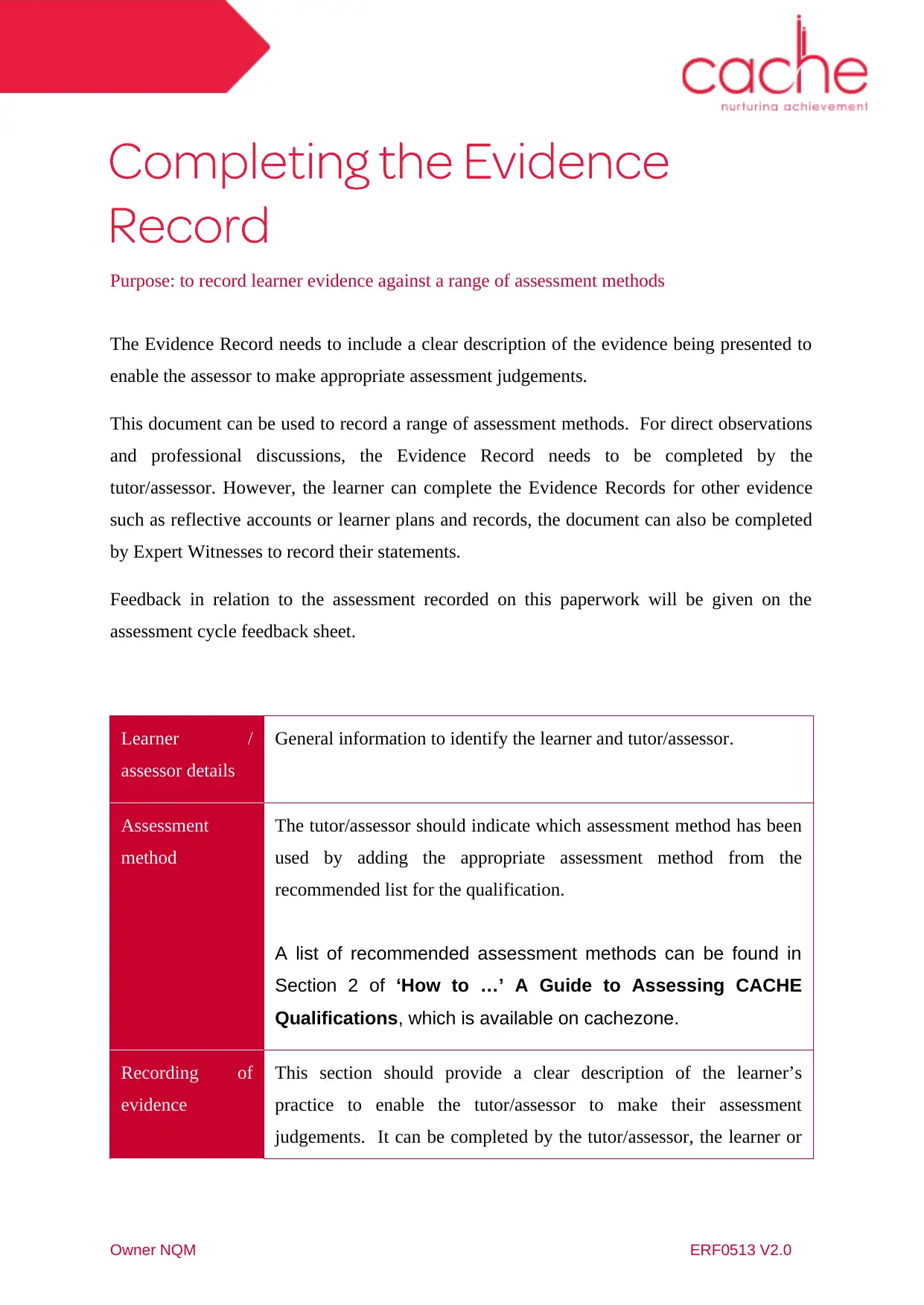
Purpose: to record learner evidence against a range of assessment methods
The Evidence Record needs to include a clear description of the evidence being presented to
enable the assessor to make appropriate assessment judgements.
This document can be used to record a range of assessment methods. For direct observations
and professional discussions, the Evidence Record needs to be completed by the
tutor/assessor. However, the learner can complete the Evidence Records for other evidence
such as reflective accounts or learner plans and records, the document can also be completed
by Expert Witnesses to record their statements.
Feedback in relation to the assessment recorded on this paperwork will be given on the
assessment cycle feedback sheet.
Learner /
assessor details
General information to identify the learner and tutor/assessor.
Assessment
method
The tutor/assessor should indicate which assessment method has been
used by adding the appropriate assessment method from the
recommended list for the qualification.
A list of recommended assessment methods can be found in
Section 2 of ‘How to …’ A Guide to Assessing CACHE
Qualifications, which is available on cachezone.
Recording of
evidence
This section should provide a clear description of the learner’s
practice to enable the tutor/assessor to make their assessment
judgements. It can be completed by the tutor/assessor, the learner or
Owner NQM ERF0513 V2.0
The Evidence Record needs to include a clear description of the evidence being presented to
enable the assessor to make appropriate assessment judgements.
This document can be used to record a range of assessment methods. For direct observations
and professional discussions, the Evidence Record needs to be completed by the
tutor/assessor. However, the learner can complete the Evidence Records for other evidence
such as reflective accounts or learner plans and records, the document can also be completed
by Expert Witnesses to record their statements.
Feedback in relation to the assessment recorded on this paperwork will be given on the
assessment cycle feedback sheet.
Learner /
assessor details
General information to identify the learner and tutor/assessor.
Assessment
method
The tutor/assessor should indicate which assessment method has been
used by adding the appropriate assessment method from the
recommended list for the qualification.
A list of recommended assessment methods can be found in
Section 2 of ‘How to …’ A Guide to Assessing CACHE
Qualifications, which is available on cachezone.
Recording of
evidence
This section should provide a clear description of the learner’s
practice to enable the tutor/assessor to make their assessment
judgements. It can be completed by the tutor/assessor, the learner or
Owner NQM ERF0513 V2.0
Paraphrase This Document
Need a fresh take? Get an instant paraphrase of this document with our AI Paraphraser
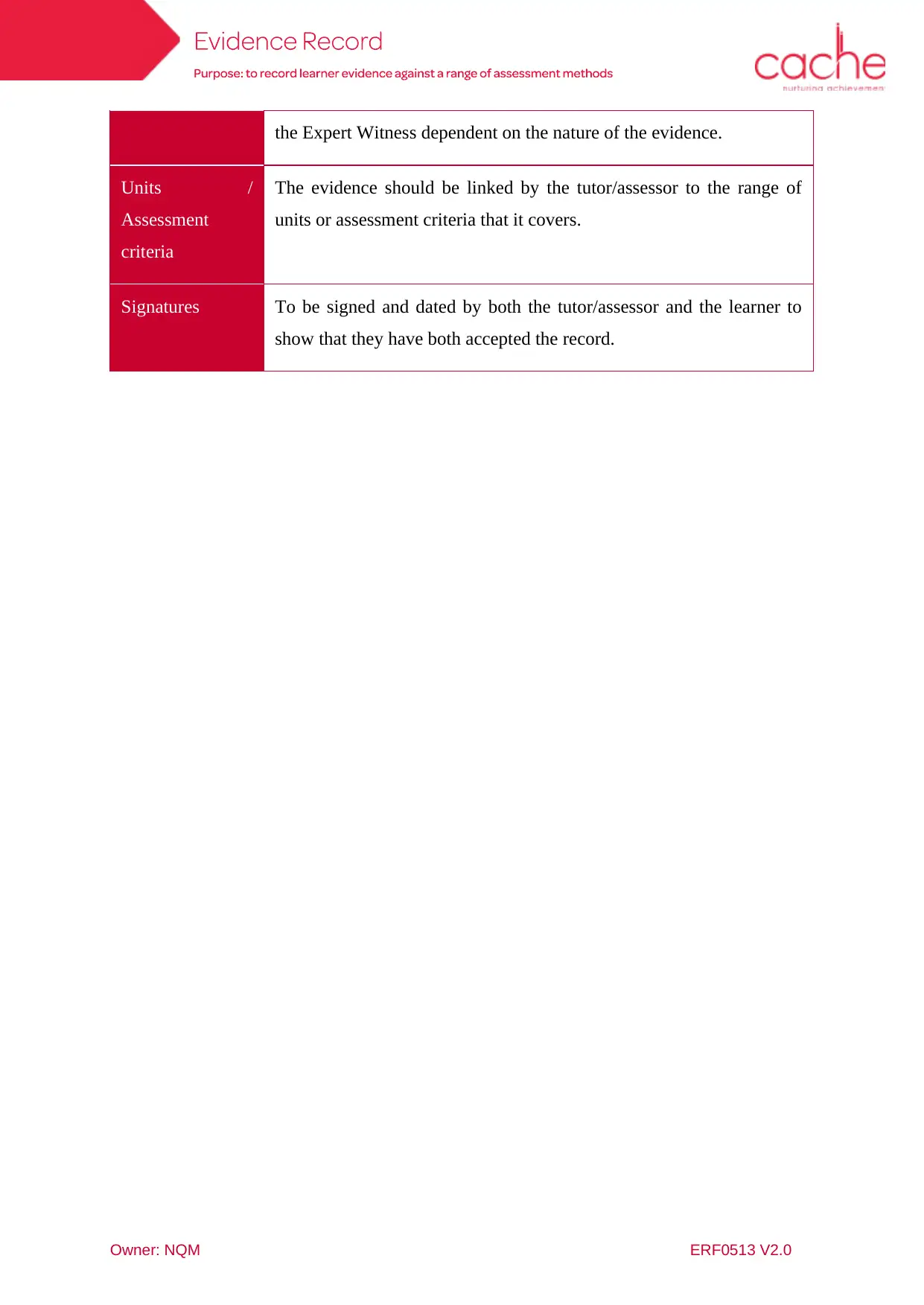
the Expert Witness dependent on the nature of the evidence.
Units /
Assessment
criteria
The evidence should be linked by the tutor/assessor to the range of
units or assessment criteria that it covers.
Signatures To be signed and dated by both the tutor/assessor and the learner to
show that they have both accepted the record.
Owner: NQM ERF0513 V2.0
Units /
Assessment
criteria
The evidence should be linked by the tutor/assessor to the range of
units or assessment criteria that it covers.
Signatures To be signed and dated by both the tutor/assessor and the learner to
show that they have both accepted the record.
Owner: NQM ERF0513 V2.0
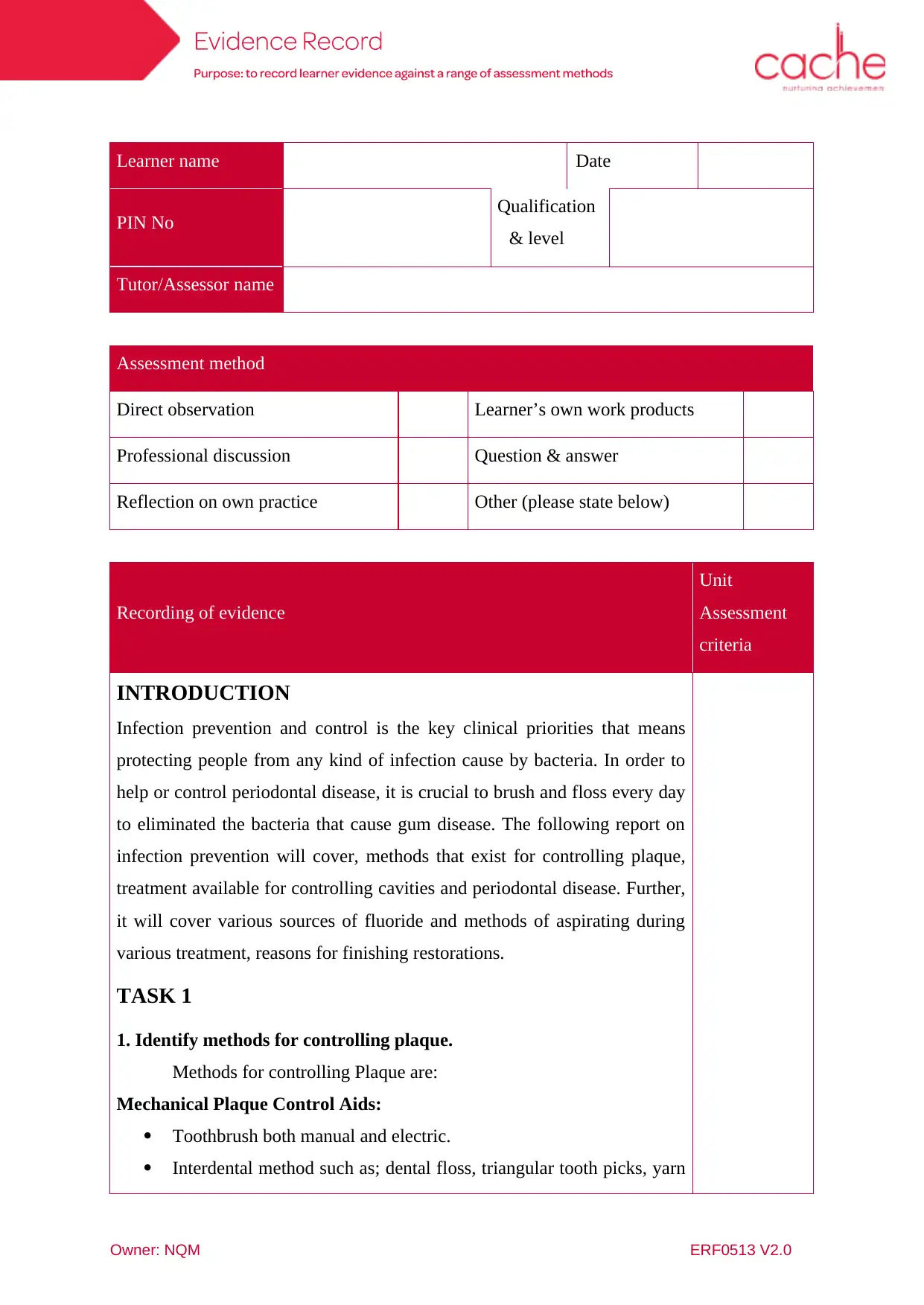
Learner name Date
PIN No Qualification
& level
Tutor/Assessor name
Assessment method
Direct observation Learner’s own work products
Professional discussion Question & answer
Reflection on own practice Other (please state below)
Recording of evidence
Unit
Assessment
criteria
INTRODUCTION
Infection prevention and control is the key clinical priorities that means
protecting people from any kind of infection cause by bacteria. In order to
help or control periodontal disease, it is crucial to brush and floss every day
to eliminated the bacteria that cause gum disease. The following report on
infection prevention will cover, methods that exist for controlling plaque,
treatment available for controlling cavities and periodontal disease. Further,
it will cover various sources of fluoride and methods of aspirating during
various treatment, reasons for finishing restorations.
TASK 1
1. Identify methods for controlling plaque.
Methods for controlling Plaque are:
Mechanical Plaque Control Aids:
Toothbrush both manual and electric.
Interdental method such as; dental floss, triangular tooth picks, yarn
Owner: NQM ERF0513 V2.0
PIN No Qualification
& level
Tutor/Assessor name
Assessment method
Direct observation Learner’s own work products
Professional discussion Question & answer
Reflection on own practice Other (please state below)
Recording of evidence
Unit
Assessment
criteria
INTRODUCTION
Infection prevention and control is the key clinical priorities that means
protecting people from any kind of infection cause by bacteria. In order to
help or control periodontal disease, it is crucial to brush and floss every day
to eliminated the bacteria that cause gum disease. The following report on
infection prevention will cover, methods that exist for controlling plaque,
treatment available for controlling cavities and periodontal disease. Further,
it will cover various sources of fluoride and methods of aspirating during
various treatment, reasons for finishing restorations.
TASK 1
1. Identify methods for controlling plaque.
Methods for controlling Plaque are:
Mechanical Plaque Control Aids:
Toothbrush both manual and electric.
Interdental method such as; dental floss, triangular tooth picks, yarn
Owner: NQM ERF0513 V2.0
⊘ This is a preview!⊘
Do you want full access?
Subscribe today to unlock all pages.

Trusted by 1+ million students worldwide
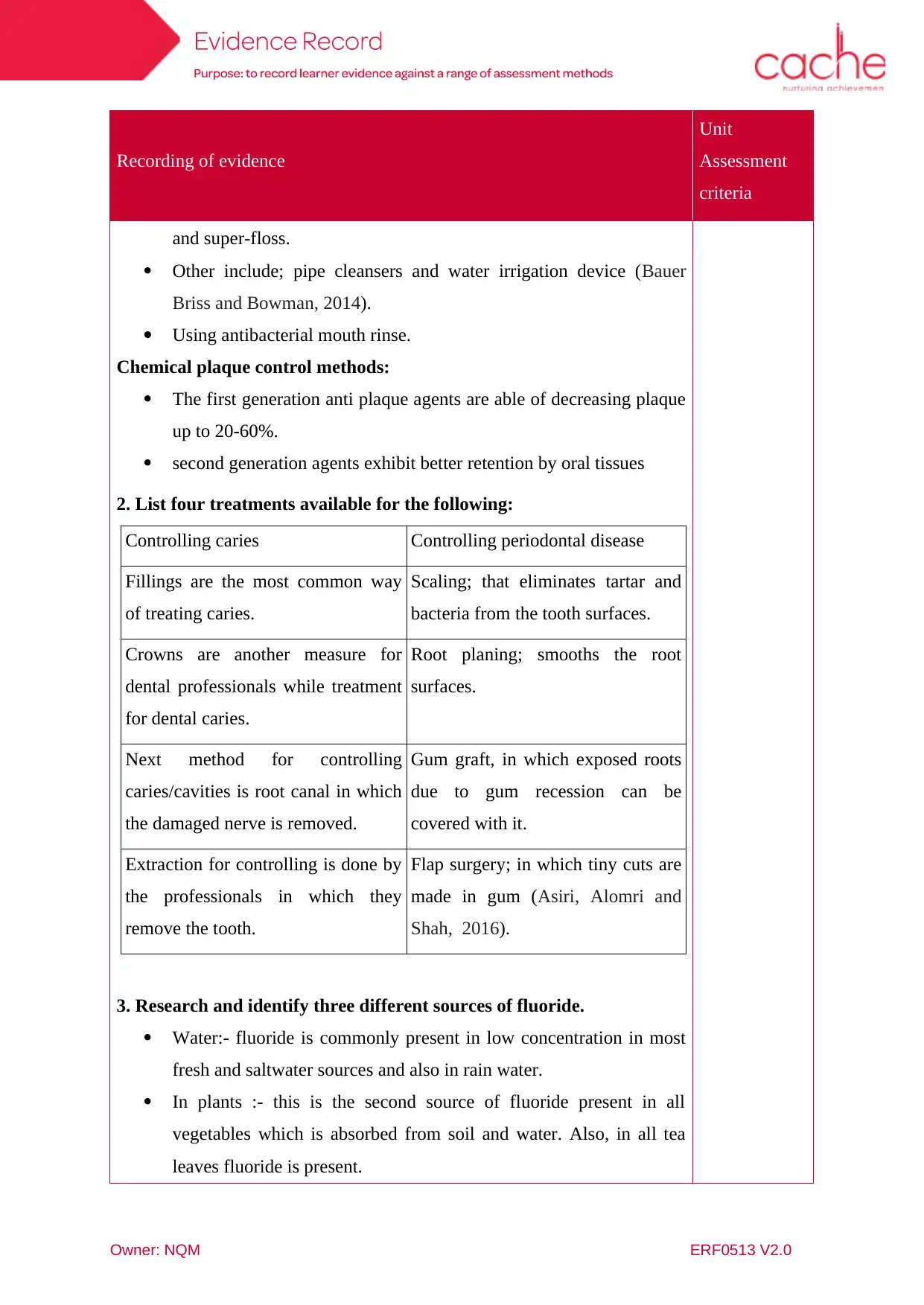
Recording of evidence
Unit
Assessment
criteria
and super-floss.
Other include; pipe cleansers and water irrigation device (Bauer
Briss and Bowman, 2014).
Using antibacterial mouth rinse.
Chemical plaque control methods:
The first generation anti plaque agents are able of decreasing plaque
up to 20-60%.
second generation agents exhibit better retention by oral tissues
2. List four treatments available for the following:
Controlling caries Controlling periodontal disease
Fillings are the most common way
of treating caries.
Scaling; that eliminates tartar and
bacteria from the tooth surfaces.
Crowns are another measure for
dental professionals while treatment
for dental caries.
Root planing; smooths the root
surfaces.
Next method for controlling
caries/cavities is root canal in which
the damaged nerve is removed.
Gum graft, in which exposed roots
due to gum recession can be
covered with it.
Extraction for controlling is done by
the professionals in which they
remove the tooth.
Flap surgery; in which tiny cuts are
made in gum (Asiri, Alomri and
Shah, 2016).
3. Research and identify three different sources of fluoride.
Water:- fluoride is commonly present in low concentration in most
fresh and saltwater sources and also in rain water.
In plants :- this is the second source of fluoride present in all
vegetables which is absorbed from soil and water. Also, in all tea
leaves fluoride is present.
Owner: NQM ERF0513 V2.0
Unit
Assessment
criteria
and super-floss.
Other include; pipe cleansers and water irrigation device (Bauer
Briss and Bowman, 2014).
Using antibacterial mouth rinse.
Chemical plaque control methods:
The first generation anti plaque agents are able of decreasing plaque
up to 20-60%.
second generation agents exhibit better retention by oral tissues
2. List four treatments available for the following:
Controlling caries Controlling periodontal disease
Fillings are the most common way
of treating caries.
Scaling; that eliminates tartar and
bacteria from the tooth surfaces.
Crowns are another measure for
dental professionals while treatment
for dental caries.
Root planing; smooths the root
surfaces.
Next method for controlling
caries/cavities is root canal in which
the damaged nerve is removed.
Gum graft, in which exposed roots
due to gum recession can be
covered with it.
Extraction for controlling is done by
the professionals in which they
remove the tooth.
Flap surgery; in which tiny cuts are
made in gum (Asiri, Alomri and
Shah, 2016).
3. Research and identify three different sources of fluoride.
Water:- fluoride is commonly present in low concentration in most
fresh and saltwater sources and also in rain water.
In plants :- this is the second source of fluoride present in all
vegetables which is absorbed from soil and water. Also, in all tea
leaves fluoride is present.
Owner: NQM ERF0513 V2.0
Paraphrase This Document
Need a fresh take? Get an instant paraphrase of this document with our AI Paraphraser
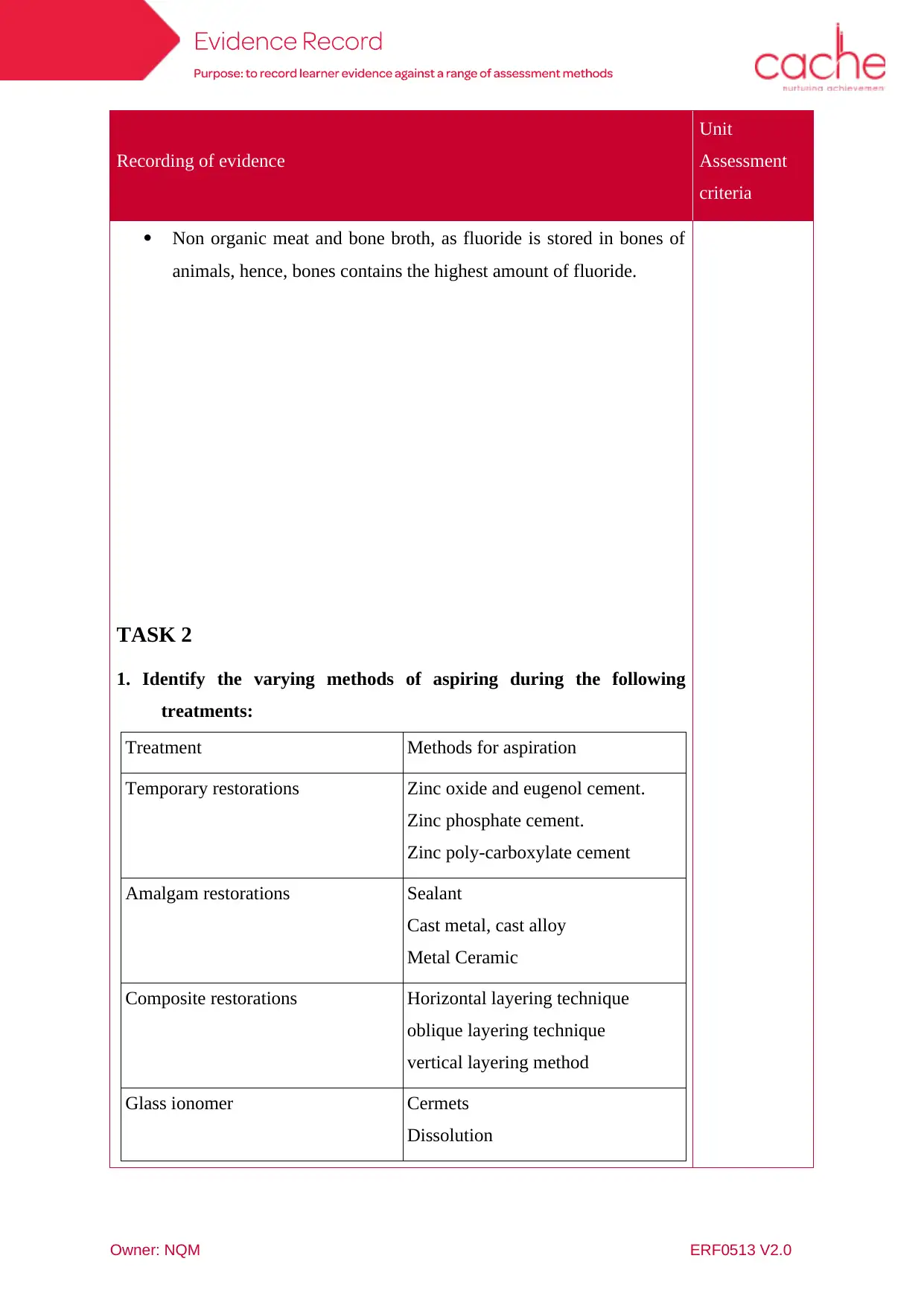
Recording of evidence
Unit
Assessment
criteria
Non organic meat and bone broth, as fluoride is stored in bones of
animals, hence, bones contains the highest amount of fluoride.
TASK 2
1. Identify the varying methods of aspiring during the following
treatments:
Treatment Methods for aspiration
Temporary restorations Zinc oxide and eugenol cement.
Zinc phosphate cement.
Zinc poly-carboxylate cement
Amalgam restorations Sealant
Cast metal, cast alloy
Metal Ceramic
Composite restorations Horizontal layering technique
oblique layering technique
vertical layering method
Glass ionomer Cermets
Dissolution
Owner: NQM ERF0513 V2.0
Unit
Assessment
criteria
Non organic meat and bone broth, as fluoride is stored in bones of
animals, hence, bones contains the highest amount of fluoride.
TASK 2
1. Identify the varying methods of aspiring during the following
treatments:
Treatment Methods for aspiration
Temporary restorations Zinc oxide and eugenol cement.
Zinc phosphate cement.
Zinc poly-carboxylate cement
Amalgam restorations Sealant
Cast metal, cast alloy
Metal Ceramic
Composite restorations Horizontal layering technique
oblique layering technique
vertical layering method
Glass ionomer Cermets
Dissolution
Owner: NQM ERF0513 V2.0

Recording of evidence
Unit
Assessment
criteria
Fissure sealants Air polishing
Fluoride treatment Tooth decay
streptococcus mutans
Scaling Professional dental cleaning
Polishing Barrel grinding
processing with emery powder
Debridement Mechanical debridement
enzymatic debridement
2. Explain the reasons for finishing restorations.
Finishing restorations involve contouring to make optimal marginal
finish without overhangs beyond the cavity margin (Elias-Boneta, Toro and
Stewart, 2015). The reason to do so is, it reduces plaque accumulation at
margins, reduces the risk of surface staining and other reasons are:
surface degradation is decreased and wear in clinical service
enhances patient and professionals satisfaction
Provides a shinier, more reflective surface, encouraging a natural
smile.
3. Explain why these methods are important when working on
restoration process.
Seating :- the fully seated dental operating position combines with
air turbine hand piece. The back rest is to assist support this lumbar
lordosis in sitting by maintaining contact.
Positioning of the patient and team :- in the field of dentistry, the
positioning of the patient and the team represented by the spatial
arrangements of the dentist's whole body around the patient.
Instrument passing :- it is discovered that, instrument passing is very
much part of dental assisting. The first hand frequently pass often
Owner: NQM ERF0513 V2.0
Unit
Assessment
criteria
Fissure sealants Air polishing
Fluoride treatment Tooth decay
streptococcus mutans
Scaling Professional dental cleaning
Polishing Barrel grinding
processing with emery powder
Debridement Mechanical debridement
enzymatic debridement
2. Explain the reasons for finishing restorations.
Finishing restorations involve contouring to make optimal marginal
finish without overhangs beyond the cavity margin (Elias-Boneta, Toro and
Stewart, 2015). The reason to do so is, it reduces plaque accumulation at
margins, reduces the risk of surface staining and other reasons are:
surface degradation is decreased and wear in clinical service
enhances patient and professionals satisfaction
Provides a shinier, more reflective surface, encouraging a natural
smile.
3. Explain why these methods are important when working on
restoration process.
Seating :- the fully seated dental operating position combines with
air turbine hand piece. The back rest is to assist support this lumbar
lordosis in sitting by maintaining contact.
Positioning of the patient and team :- in the field of dentistry, the
positioning of the patient and the team represented by the spatial
arrangements of the dentist's whole body around the patient.
Instrument passing :- it is discovered that, instrument passing is very
much part of dental assisting. The first hand frequently pass often
Owner: NQM ERF0513 V2.0
⊘ This is a preview!⊘
Do you want full access?
Subscribe today to unlock all pages.

Trusted by 1+ million students worldwide
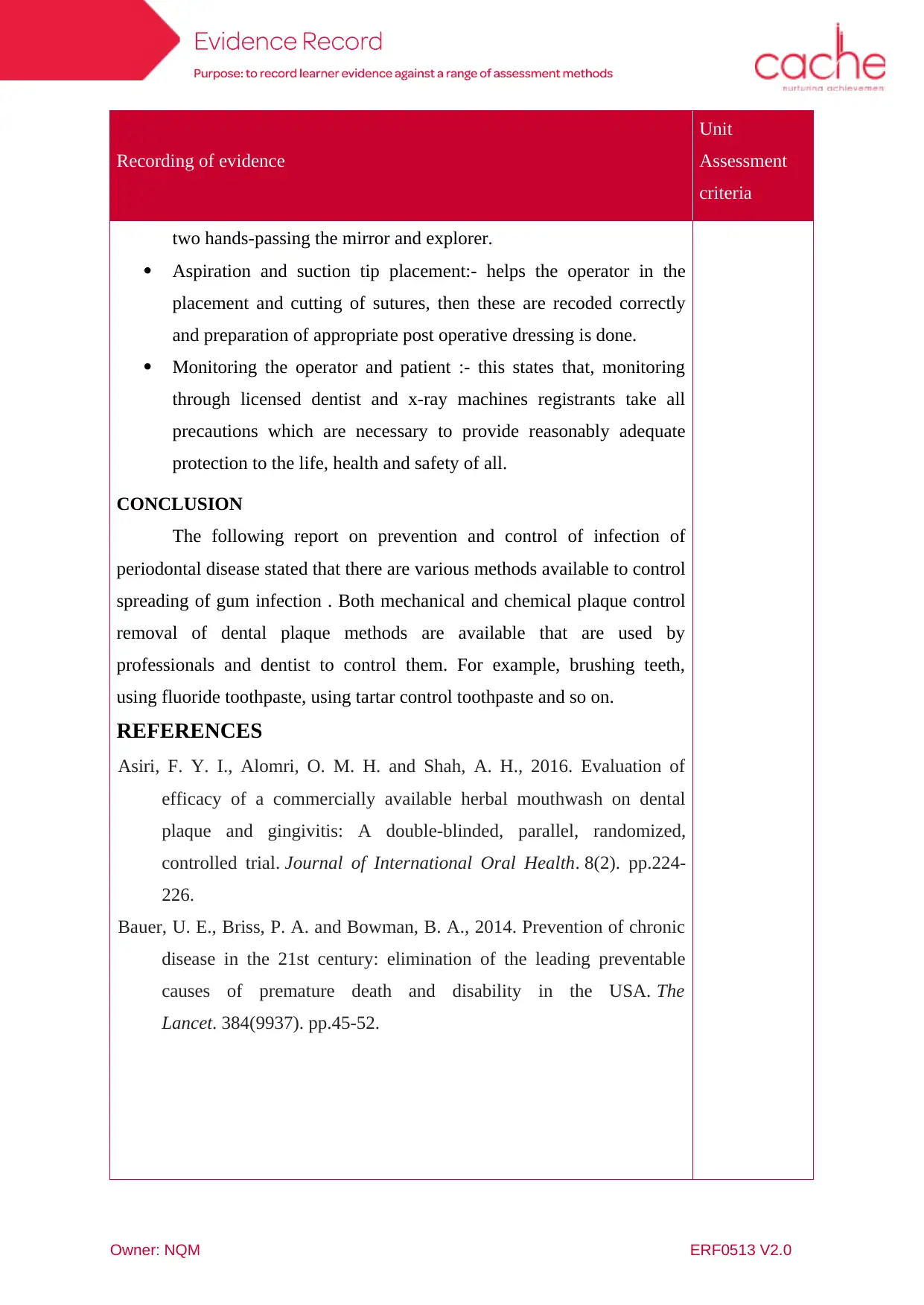
Recording of evidence
Unit
Assessment
criteria
two hands-passing the mirror and explorer.
Aspiration and suction tip placement:- helps the operator in the
placement and cutting of sutures, then these are recoded correctly
and preparation of appropriate post operative dressing is done.
Monitoring the operator and patient :- this states that, monitoring
through licensed dentist and x-ray machines registrants take all
precautions which are necessary to provide reasonably adequate
protection to the life, health and safety of all.
CONCLUSION
The following report on prevention and control of infection of
periodontal disease stated that there are various methods available to control
spreading of gum infection . Both mechanical and chemical plaque control
removal of dental plaque methods are available that are used by
professionals and dentist to control them. For example, brushing teeth,
using fluoride toothpaste, using tartar control toothpaste and so on.
REFERENCES
Asiri, F. Y. I., Alomri, O. M. H. and Shah, A. H., 2016. Evaluation of
efficacy of a commercially available herbal mouthwash on dental
plaque and gingivitis: A double-blinded, parallel, randomized,
controlled trial. Journal of International Oral Health. 8(2). pp.224-
226.
Bauer, U. E., Briss, P. A. and Bowman, B. A., 2014. Prevention of chronic
disease in the 21st century: elimination of the leading preventable
causes of premature death and disability in the USA. The
Lancet. 384(9937). pp.45-52.
Owner: NQM ERF0513 V2.0
Unit
Assessment
criteria
two hands-passing the mirror and explorer.
Aspiration and suction tip placement:- helps the operator in the
placement and cutting of sutures, then these are recoded correctly
and preparation of appropriate post operative dressing is done.
Monitoring the operator and patient :- this states that, monitoring
through licensed dentist and x-ray machines registrants take all
precautions which are necessary to provide reasonably adequate
protection to the life, health and safety of all.
CONCLUSION
The following report on prevention and control of infection of
periodontal disease stated that there are various methods available to control
spreading of gum infection . Both mechanical and chemical plaque control
removal of dental plaque methods are available that are used by
professionals and dentist to control them. For example, brushing teeth,
using fluoride toothpaste, using tartar control toothpaste and so on.
REFERENCES
Asiri, F. Y. I., Alomri, O. M. H. and Shah, A. H., 2016. Evaluation of
efficacy of a commercially available herbal mouthwash on dental
plaque and gingivitis: A double-blinded, parallel, randomized,
controlled trial. Journal of International Oral Health. 8(2). pp.224-
226.
Bauer, U. E., Briss, P. A. and Bowman, B. A., 2014. Prevention of chronic
disease in the 21st century: elimination of the leading preventable
causes of premature death and disability in the USA. The
Lancet. 384(9937). pp.45-52.
Owner: NQM ERF0513 V2.0
Paraphrase This Document
Need a fresh take? Get an instant paraphrase of this document with our AI Paraphraser
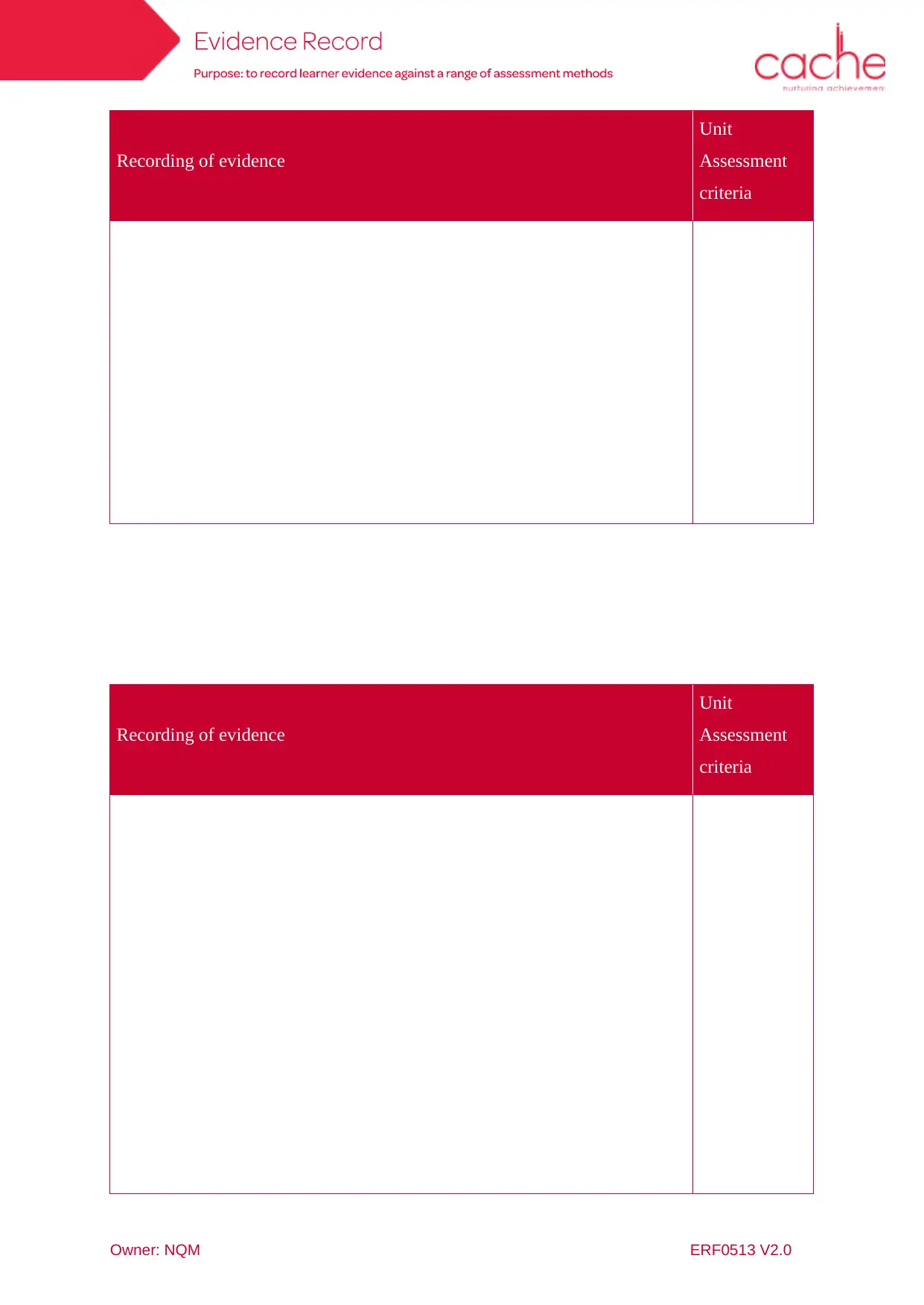
Recording of evidence
Unit
Assessment
criteria
Recording of evidence
Unit
Assessment
criteria
Owner: NQM ERF0513 V2.0
Unit
Assessment
criteria
Recording of evidence
Unit
Assessment
criteria
Owner: NQM ERF0513 V2.0
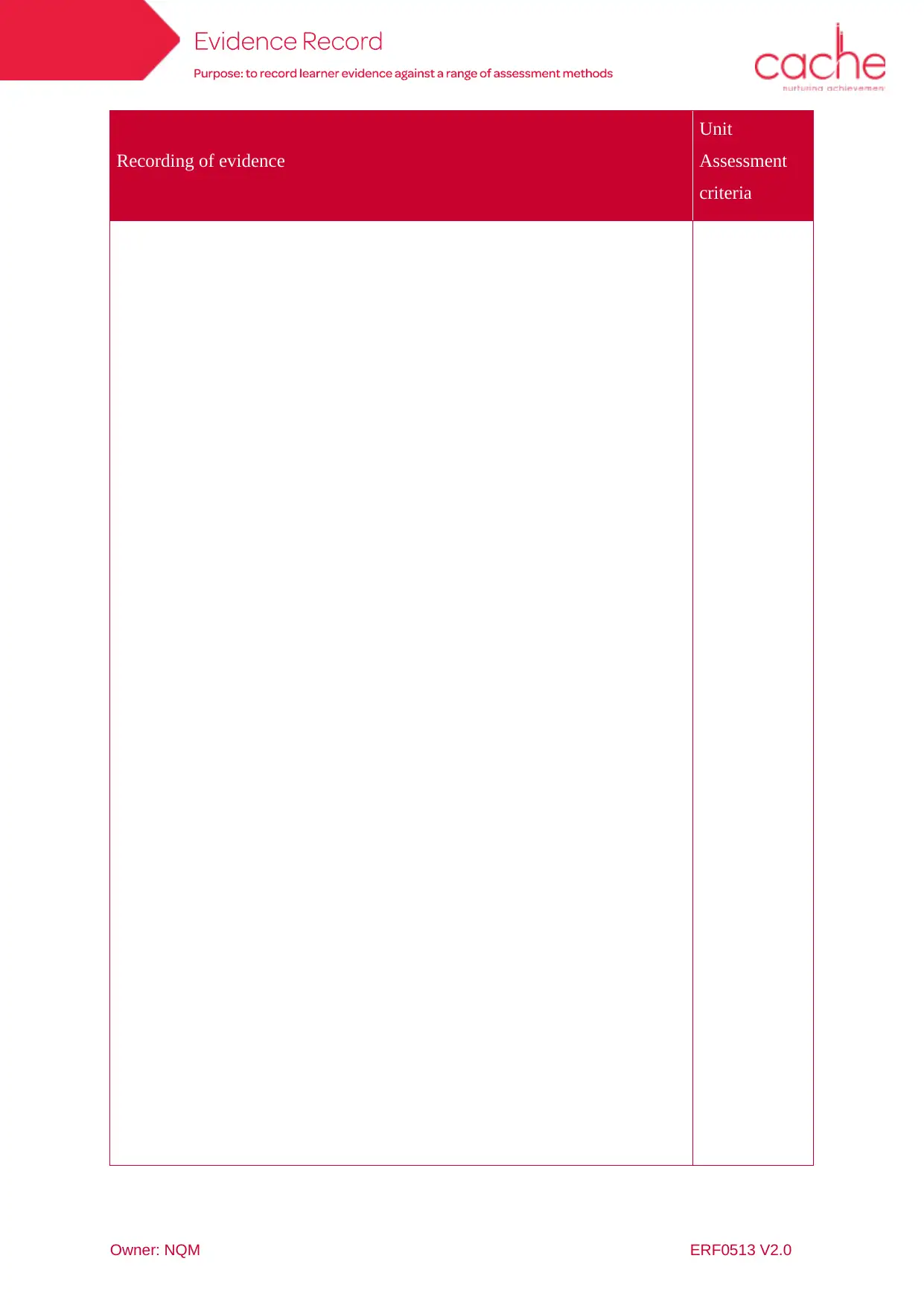
Recording of evidence
Unit
Assessment
criteria
Owner: NQM ERF0513 V2.0
Unit
Assessment
criteria
Owner: NQM ERF0513 V2.0
⊘ This is a preview!⊘
Do you want full access?
Subscribe today to unlock all pages.

Trusted by 1+ million students worldwide
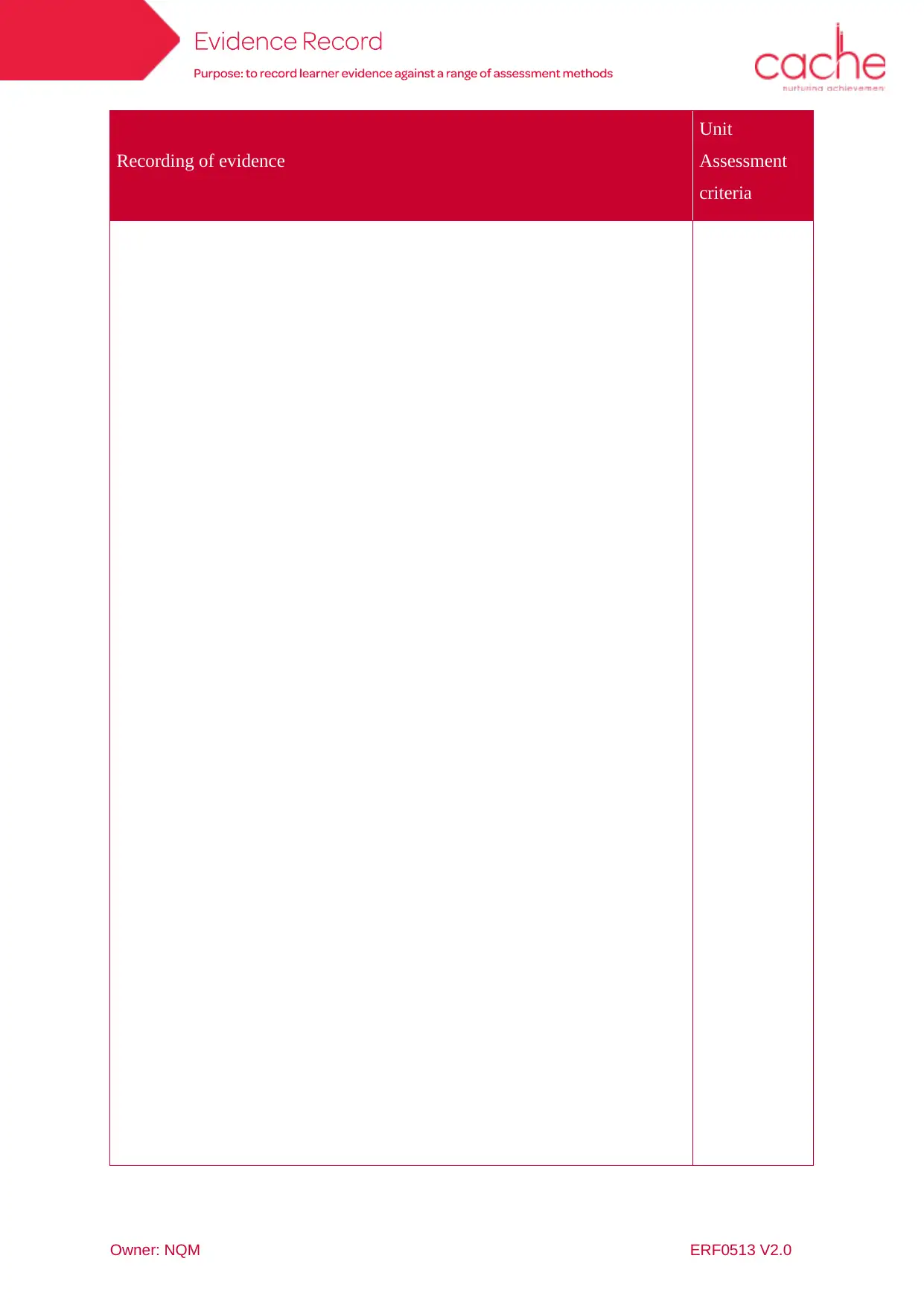
Recording of evidence
Unit
Assessment
criteria
Owner: NQM ERF0513 V2.0
Unit
Assessment
criteria
Owner: NQM ERF0513 V2.0
Paraphrase This Document
Need a fresh take? Get an instant paraphrase of this document with our AI Paraphraser
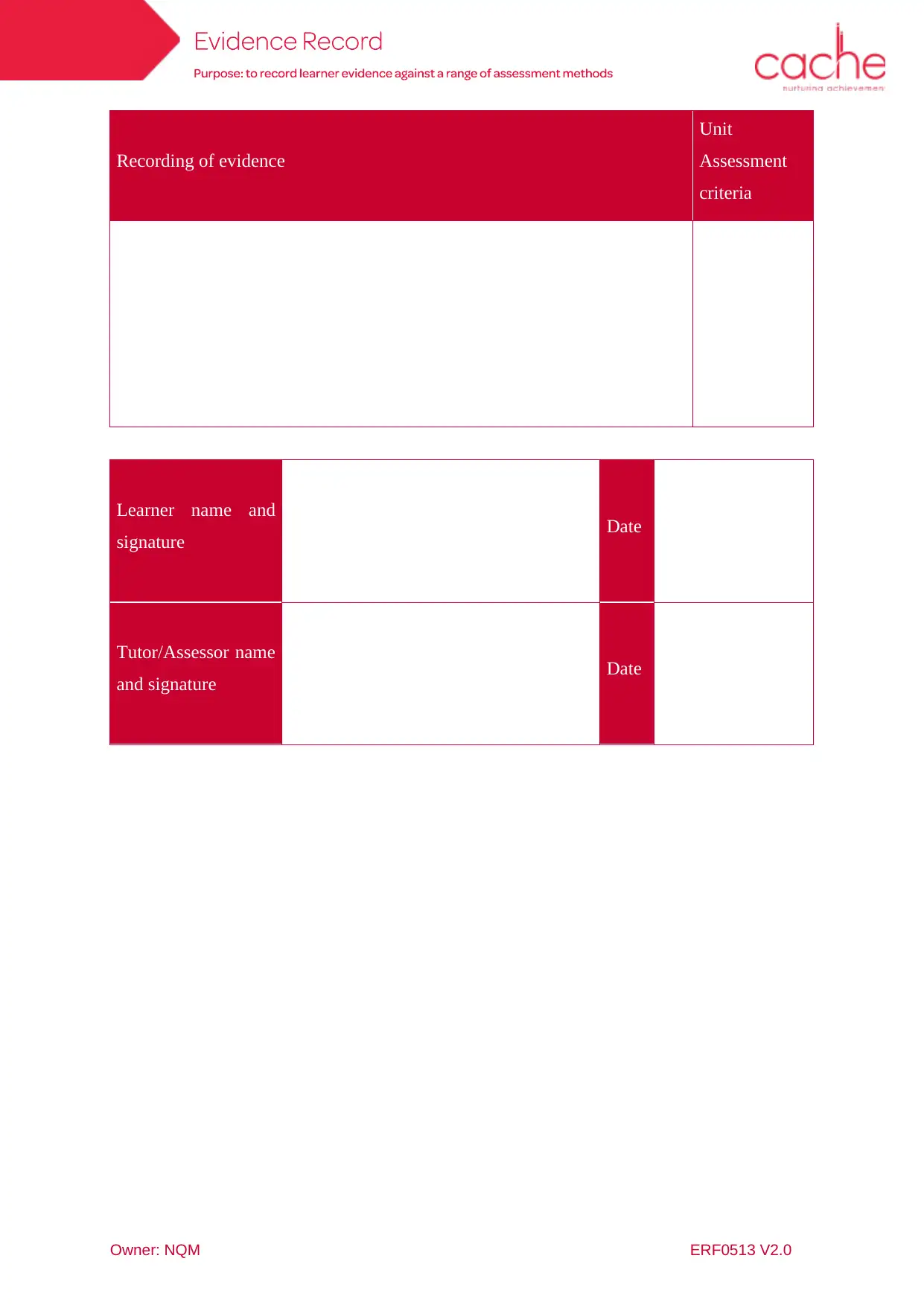
Recording of evidence
Unit
Assessment
criteria
Learner name and
signature Date
Tutor/Assessor name
and signature Date
Owner: NQM ERF0513 V2.0
Unit
Assessment
criteria
Learner name and
signature Date
Tutor/Assessor name
and signature Date
Owner: NQM ERF0513 V2.0
1 out of 11
Related Documents
Your All-in-One AI-Powered Toolkit for Academic Success.
+13062052269
info@desklib.com
Available 24*7 on WhatsApp / Email
![[object Object]](/_next/static/media/star-bottom.7253800d.svg)
Unlock your academic potential
Copyright © 2020–2025 A2Z Services. All Rights Reserved. Developed and managed by ZUCOL.





